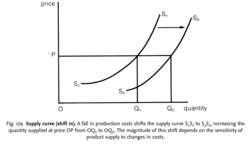supply curve
see EQUILIBRIUM MARKET PRICE.supply curve
a line showing the relationship between the PRICE of a PRODUCT or FACTOR OF PRODUCTION and the quantity supplied per time period. ‘Supply’ means the total quantity of a product or factor that firms or factor owners are prepared to sell at a given price.The typical market supply curve for a product slopes upwards from left to right, indicating that as price rises more is supplied (that is, a movement along the existing supply curve). Thus, if price rises from OP1, to OP2 in Fig. 178, the quantity supplied will increase from OQ1, to OQ2 .
Fig. 178 shows the supply curve for the market as a whole. This curve is derived by aggregating the individual supply curves of all the producers of the good, which in turn are derived from the producers’ cost curves.
Most supply curves slope upwards because, as the price of the product rises, producers will find it more profitable to manufacture, using their existing production facilities, and because any increase in short-run MARGINAL COSTS associated with increasing output will be covered by the higher price obtained.
The slope of the supply curve reflects the degree of responsiveness of quantity supplied to changes in the product's price. For example, if a large rise in price results in only a small increase in quantity supplied (as would be the case where the supply curve has a steep slope), then supply is said to be price-inelastic (see PRICE-ELASTICITY OF SUPPLY).
The supply curve interacts with the DEMAND CURVE to determine the EQUILIBRIUM MARKET PRICE. See SUPPLY CURVE, (SHIFT IN), SUPPLY FUNCTION.

